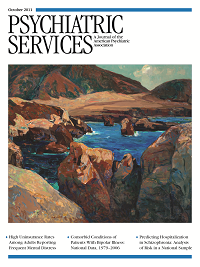Past-month use of illicit drugs increased significantly between 2008 and 2010, according to the National Survey on Drug Use and Health (NSDUH). In 2010 a total of 22.6 million Americans age 12 and older—8.9% of the population—reported current illicit drug use. This rate is similar to the 2009 rate of 8.7% but higher than the 2008 rate of 8.0%.The increase appears largely attributable to the rise in past-month use of marijuana, which has increased by 21% since 2007—from 5.8% to 6.9%, or from 14.4 million Americans in 2007 to 17.4 million in 2010.
Past-month binge drinking (five or more drinks during one session) was reported by nearly one-quarter of the population (23.1%)—an estimated 58.6 million people. The rate was even higher at 40.6% among young adults age 18 to 25, and it was highest in the 21–25 age group at 45.5%. In 2010 current use of alcohol was reported by slightly more than half of Americans age 12 and older (51.8%). Among young people, rates of past-month alcohol use by age group were as follows: 12 or 13 years, 3.1%; 14 or 15 year, 12.4%; 16 or 17 years, 24.6%; 18 to 20 years, 48.9%; and 21 to 25 years, 70.0%. Among older age groups, the prevalence of current use decreased with increasing age, from 65.3% in the 26–29 age group to 51.6% among those age 60 to 64 and to 38.2% among those age 65 or older.
NSDUH is the primary source of statistical information on the use of drugs, alcohol, and tobacco by the U.S. civilian, noninstitutionalized population age 12 and older. Conducted since 1971, the survey collects data through face-to-face interviews with a representative sample of the population at the respondent's place of residence. The survey of approximately 67,500 people is sponsored by the Substance Abuse and Mental Health Services Administration (SAMHSA).
In 2010 marijuana was the most commonly used illicit drug—used by 76.8% of current illicit drug users—and it was the only drug used by 60.1% of them. Nine million persons age 12 and older (3.6% of the population and 39.9% of illicit drug users) reported past-month use of illicit drugs other than marijuana. Most of this group (7.0 million persons) reported nonmedical use of prescription drugs, including 5.1 million users of pain relievers, 2.2 million users of tranquilizers, 1.1 million users of stimulants, and 374,000 users of sedatives. Most (55%) of those reporting nonmedical use of prescription pain relievers received them for free from a friend or relative; only 4.4% reported purchasing them from a drug dealer and .4% bought them on the Internet.
Between 2002 and 2010, the number of persons with past-year substance abuse or dependence has remained stable. In 2010, an estimated 22.1 million persons were classified as having a substance use disorder (8.7% of the population age 12 and older): 2.9 million with co-occurring alcohol and drug use disorders, 4.2 million with drug but not alcohol use disorders, and 15.0 million with alcohol but not drug use disorders.
As in previous years, 2010 NSDUH data show a very large disparity between the number of people needing specialized treatment for a substance use problem and the number who actually receive it. According to the survey, 23.1 million Americans age 12 and older (9.1%) needed such treatment, but only 2.6 million, or 11.2% of them, received it at a specialty treatment facility, defined as a hospital (inpatient only), drug or alcohol rehabilitation facility (inpatient or outpatient), or mental health center. More broadly, the number receiving substance use treatment of any kind—specialty treatment as well as treatment received in an emergency department, private doctor's office, self-help group, prison or jail, or hospital as an outpatient—totaled 4.1 million, or 1.6% of the population age 12 and older.
Despite some troubling trends, the 2010 NSDUH showed areas of improvement in terms of lower use levels of some substances. The number of current methamphetamine users decreased by roughly half from 2006 to 2010—from 731,000 people age 12 and older (.3%) to 353,000 (.1%). Cocaine use has also declined, from 2.4 million current users in 2006 to 1.5 million in 2010. In addition, in the 12- to 17-year age group, decreases between 2009 and 2010 were found in rates of past-month drinking (from 14.7% to 13.6%) and tobacco use (from 11.6% to 10.7%).

